Simmered Taro (Satoimo no Nimono) is a classic home-cooked recipe that complements the main dish in a typical Japanese meal. This side dish is a humble yet wonderful way to appreciate the remarkable texture and pleasant sweetness of this starchy root vegetable.
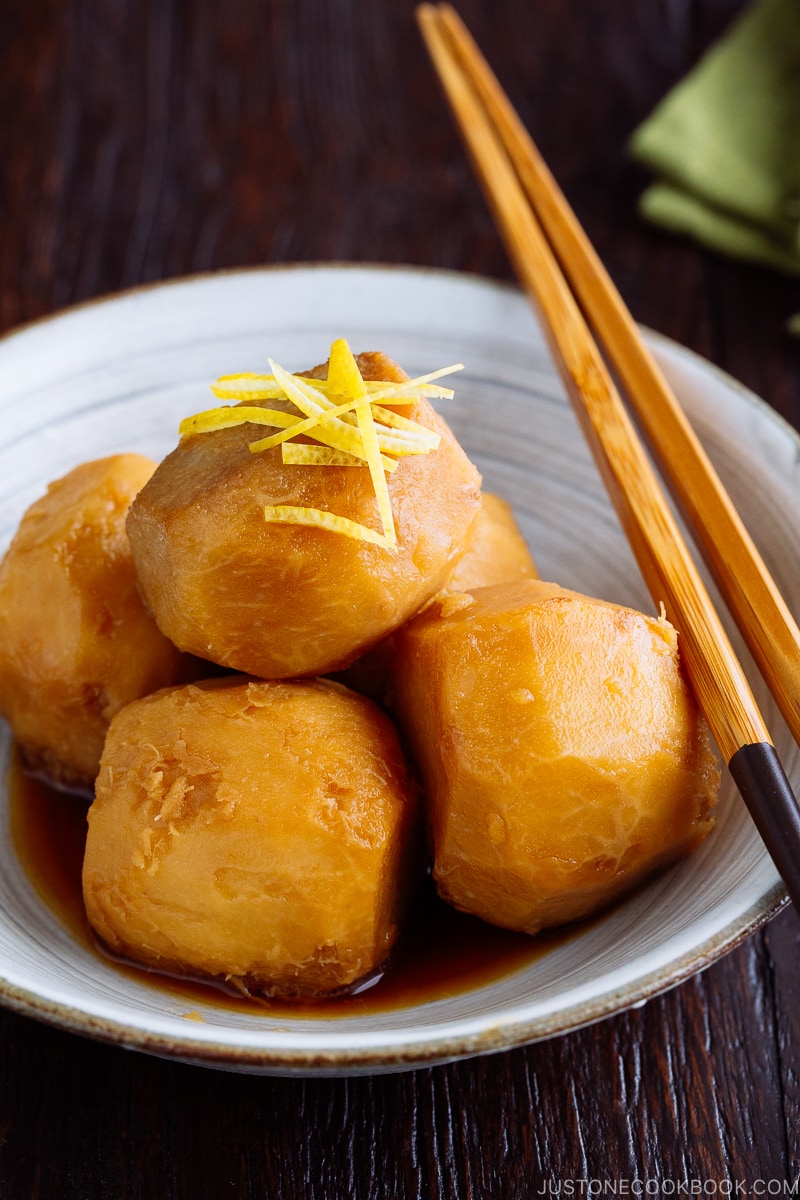
Simmered Taro, is a classic simmered dish in Japan. In Japanese, we call this dish Satoimo no Nimono (里芋の煮物) or Satoimo no Nikkorogashi (里芋の煮っころがし). Just like the other simmered dishes, simmered taro is cooked with the basic Japanese seasonings – dashi (Japanese soup stock), sake, soy sauce, mirin, and some sugar. The simplicity of this preparation allows taro to take the center stage while it soaks up the savory flavor of the sauce.
What’s Taro?
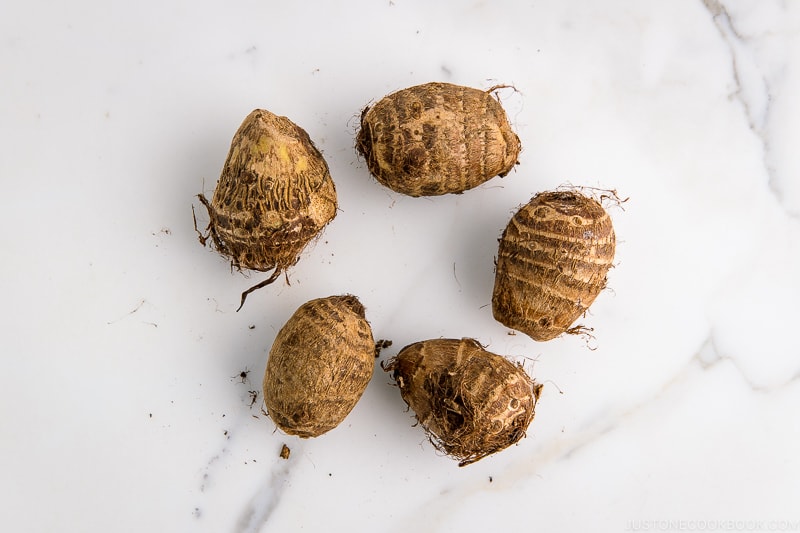
If you’re unfamiliar with taro, it is a starchy root crop that is known for its nutritional values and essential minerals. The variety of taro varies in size and shape, but the ones we use for Japanese cuisine are often smaller, round, dark in color, and hairy. These unassuming root vegetables are called Satoimo (里芋) in Japanese and you can find them at Japanese or other Asian grocery stores. Simmered Taro is very simple to prepare, which is why it has been a popular home-cooked dish.
How to Prepare Taro
While the recipe for simmered taro is uncomplicated, there are a few things you want to take note of when preparing taro. If consumed raw, it can cause mild irritation and itchiness and the flesh is slimy. Why then bother cooking with it? Well, aside from its many nutritional values, taro is appreciated for its unique texture and ability to soak up flavors. Give it a try and you’ll discover why it is widely enjoyed in Japanese cuisine.
I include some tips below on how to prepare taro, especially if this is your first time cooking with taro.
- Taro has hairy, tough, and thick skin which is hard to peel with a peeler. Make sure to rinse it well underwater and remove the hair as much as you can.
- Cut off both ends first and peel from one end to the other end. And it’s okay to peel the thick skin off.
- To get rid of the sliminess, use salt to rub the taro and rinse under cold water.
- Boil the taro to get rid of the bitterness and foam/scum. Drain the water completely and the taro is ready to get seasoned!
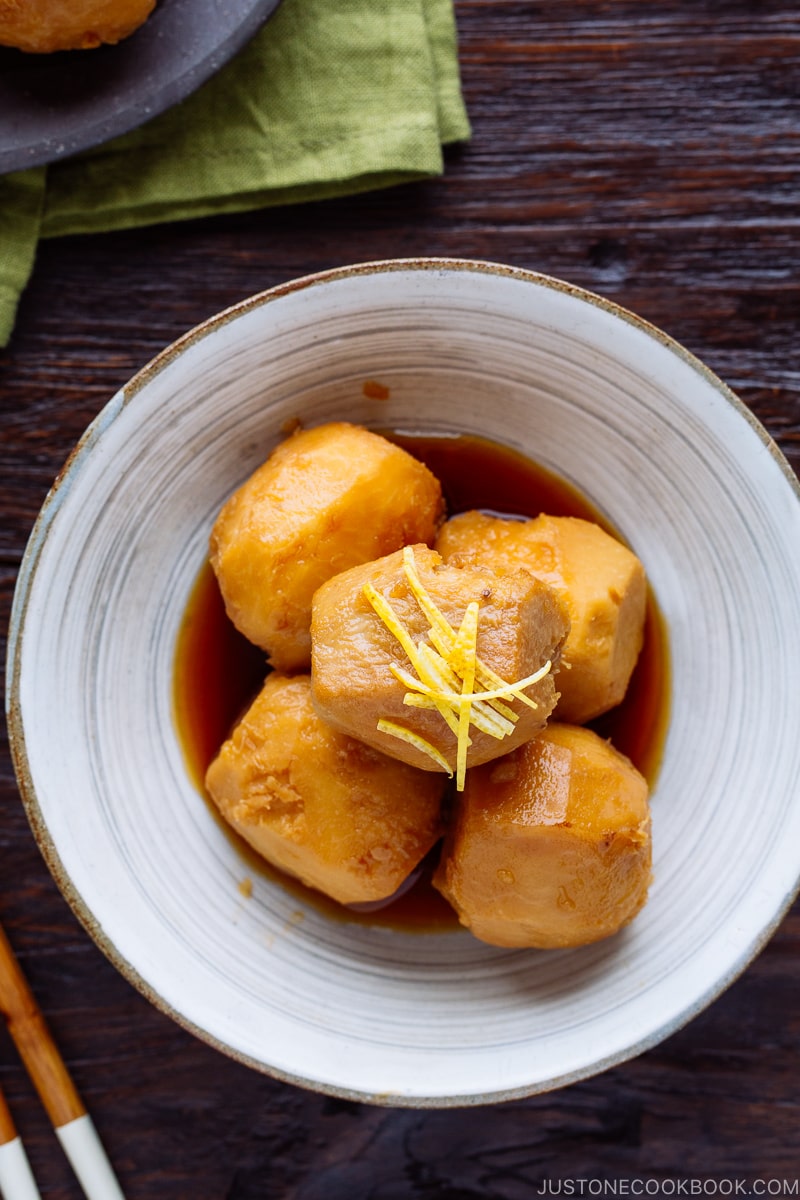
Tips to Make Best Simmered Taro
1. Blanch taro first to avoid bitterness
If you start cooking taro directly in a simmering sauce, taro will release bitterness and affects the final taste. Therefore, it’s best to blanch taro first before coating it with savory sauce.
2. Coat the taro with oil after pre-blanching
The oil helps lock in all the flavors inside the taro and prevent umami from going away. It also helps to keep the shape without breaking into pieces.
3. Season with sweet condiments before salty condiments
When working with an ingredient that requires some time to cook, make sure to season it with sweet condiments such as mirin and sugar. If you add salt or salty condiment, the natural sweetness of the ingredient will be lost and it requires more sugar/mirin to sweeten again.
4. Use otoshibuta (drop lid) to keep the taro submerged at all times
Otoshibuta is an essential kitchen tool to make nimono or simmered dishes in Japan. The drop lid helps the ingredient submerge in the simmering sauce at all times while preventing the sauce from evaporating too fast. It also keeps the taro steady in place so it won’t break down into pieces. You can buy an adjustable stainless drop lid like mine or you can make your own otoshibuta with aluminum foil.
5. Drizzle mirin last for luster
Mirin is known for adding luster to the dish, which is why mirin is an essential ingredient when you make Teriyaki (as Teri means “luster” in Japanese). Not only it adds sweetness, but it adds beautiful and delicious shine to the dish right before you turn off the heat and serve.
What Other Dishes to Serve
You can serve the simmered taro in the Ichiju Sansai ‘one soup three dishes’ style, by complementing it with braised pork belly (kakuni), chawanmushi, steamed rice, pickled cucumber and miso soup.
Wish to learn more about Japanese cooking? Sign up for our free newsletter to receive cooking tips & recipe updates! And stay in touch with me on Facebook, Pinterest, YouTube, and Instagram.

Simmered Taro (Satoimo no Nimono)
Ingredients
- 10 taro (satoimo) (1¾ lb, 800 g)
- ½ tsp Diamond Crystal kosher salt
- 2 tsp neutral oil
For the Seasonings
- 1¼ cups dashi (Japanese soup stock) (use standard Awase Dashi, dashi packet or powder, or Vegan Dashi)
- 3 Tbsp sake
- 2 Tbsp sugar
- 2 Tbsp soy sauce
- 1 Tbsp mirin
For the Garnish
- yuzu peel (or julienned lemon peel; optional)
Instructions
- Gather all the ingredients.
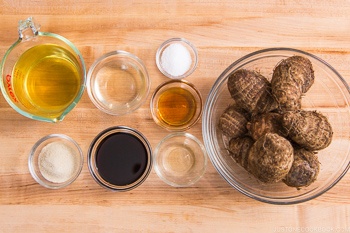
- Wash 10 taro (satoimo) with water and drain. Cut both ends and peel the skin. Taro is slimy, so be careful when you’re handling it with the knife.
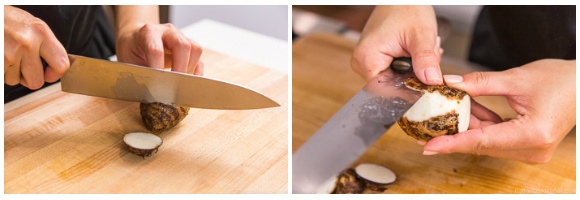
- Sprinkle ½ tsp Diamond Crystal kosher salt over the taro and rub it with your hands. Then, rinse under cold water and drain completely.
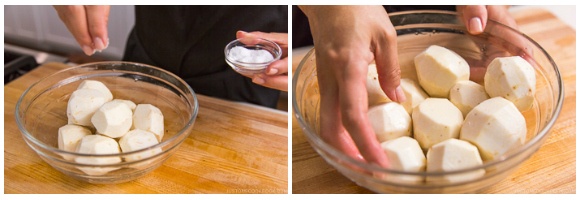
- Now, pre-blanch the taro. Place the taro in a large pot and add enough water to cover the taro. Bring the water to a boil.
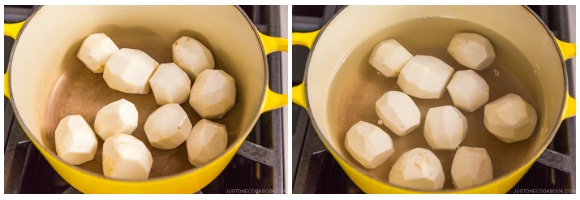
- Once boiling, reduce the heat and simmer for 5 minutes, or until a skewer inserted into the taro goes through smoothly. Pre-blanching helps the taro absorb flavors when simmering in seasonings. Drain and rinse off the sliminess under warm water.
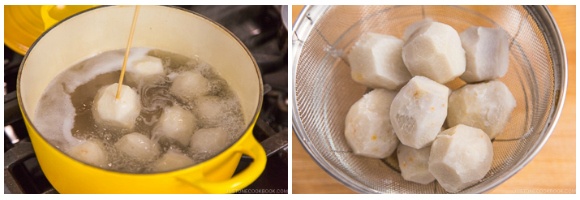
- Heat 2 tsp neutral oil in the pot. Add the taro and quickly coat it with the oil. The oil helps lock the flavors inside the taro and prevent umami from going away. It also helps the taro keep its shape without breaking into pieces.
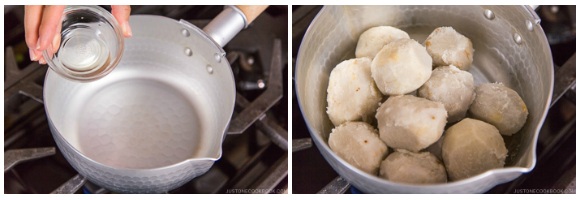
- Add 1¼ cups dashi (Japanese soup stock), 3 Tbsp sake, and 2 Tbsp sugar, and bring it to a boil. Skim if necessary.
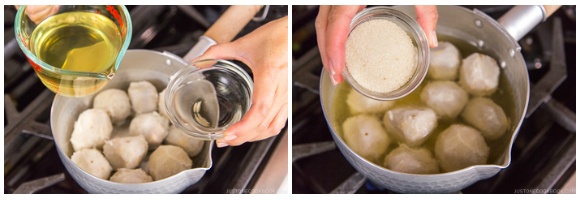
- Lower the heat and place an otoshibuta (drop lid) on top. Simmer for 5 minutes.
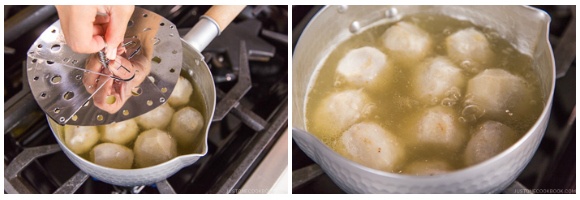
- Remove the otoshibuta and add 2 Tbsp soy sauce; adding the soy sauce later helps the sweet flavors easily soak in. Place the otoshibuta back on and simmer for another 20–25 minutes (depending on the size of your taro; mine are large). Lastly, add 1 Tbsp mirin and gently shake the pot to coat the taro with the sauce. Adding the mirin toward the end gives a nice luster to the dish.
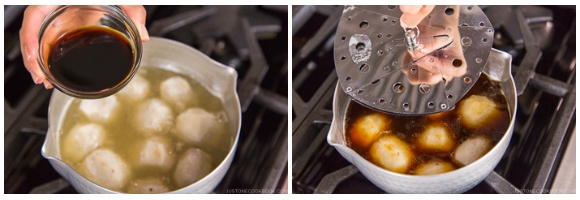
- Garnish with julienned yuzu peel, if you‘d like.
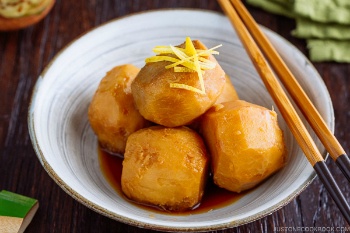
To Store
- You can keep the leftovers in an airtight container and store in the refrigerator for up to 3–4 days.
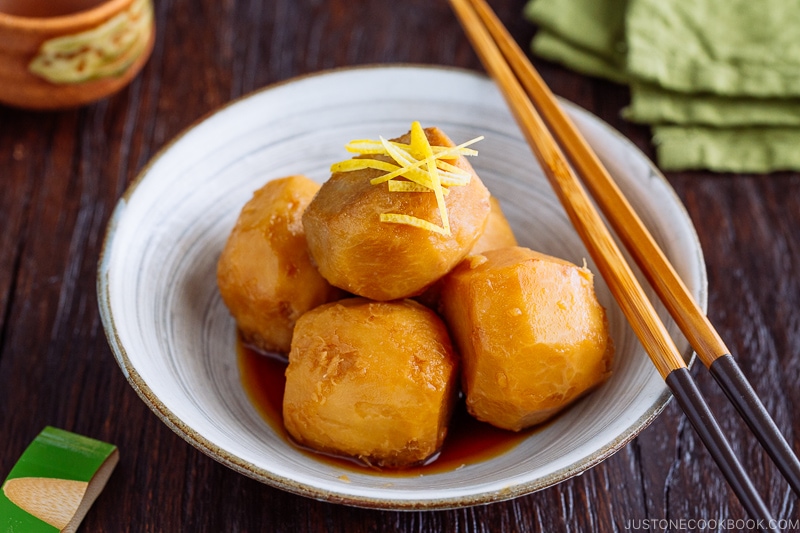

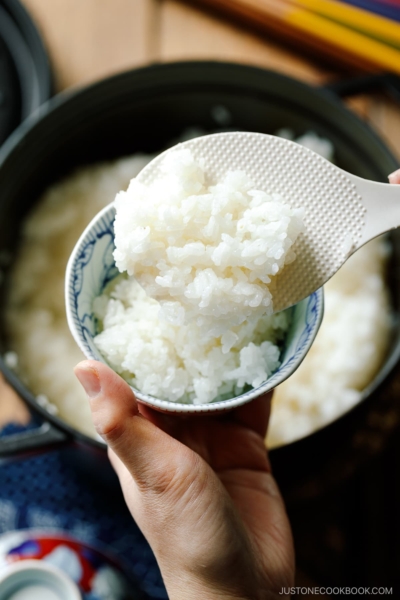

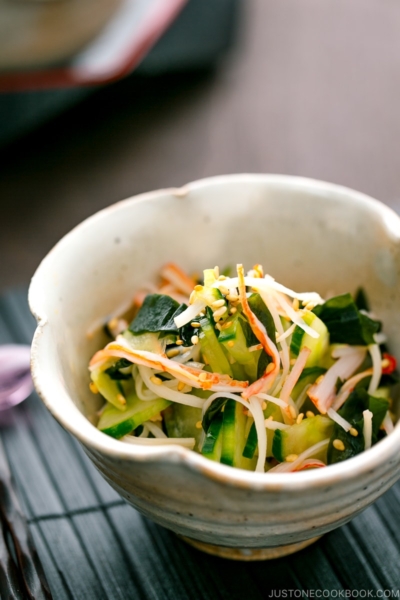




Thanks for this recipe. My neighbor gave me a few taro roots and I had no idea what to do with them. The next day, her husband came over to give me his wife’s version of satoimo ni ninono, which tasted good, but I had no idea how to make it. You saved the day!
Hello, Barbara. Thank you so much for reading Nami’s post and for your kind feedback.
We hope you enjoyed her recipe and the flavors of the Taro. Happy cooking! 🥰
So perfect. I learned so much from this recipe… it’s so helpful in explaining the purpose or reasoning for steps that I might have otherwise tried to combine or simplify.
I did add 1/4 tsp dark soy sauce to get the color, and I cut the bigger taro roots down to match the size of the smaller ones—that also helped them cook a little faster.
Served as part of a Valentine’s Day ichiju sansai, which I also learned about today from your site!
Hi Sasen! Thank you so much for your kind feedback!
We are so happy to hear that you enjoyed Nami’s recipe and everything else we shared with you.
We hope you continue to enjoy learning Japanese cooking with us. Happy Cooking!😊
Hi Nami, what do you usually do with the simmering liquid for this and other simmered dishes, like kabocha? The dish isn’t served with the liquid and it feels kind of wasteful to throw it away, so curious if there’s another use for it?
Hi Brenda! Thank you very much for trying Nami’s recipe!
You can use the leftover liquid as a sauce to cook other greens. Or mix it with eggs and make a scrambled egg, etc. Simply pouring the liquid over steamed rice or cooking rice with other vegetables are also good (like Takikomi Gohan: https://www.justonecookbook.com/takikomi-gohan/. 😉
We hope this helps!
I used it as a dipping sauce for cold soba.
Nami, I am always checking your site for recipes whenever I got an ingredient that I want to turn into a Japanese dish. And this time I got some baby taros sitting in my pantry. Also, I missed out going to Kappabashi (based on your suggestion for kitchenware hunt) on my trip to Tokyo in 2019 because our family were having so much fun looking for places to eat. But for sure next time, I will go there.
Hi Julie, Thank you very much for your kind feedback and for sharing your story with us!
Nami is happy to hear that you always check the JOC site for Japanese recipes. Thank you very much.
We hope you have a chance to visit Kappabashi Kitchenware street on your next visit and find nice kitchen tools and plates to bring home. 🙂
I am grateful to live in Japan once again, and visit Kappabashi at least once a year. It’s a great place to visit for anyone who enjoys cooking. As for me, I swear I have every kitchen gadget, even when I don’t know how to use them. I love going there if for no other reason than to look at what’s new. Did you know that most of the larger stores in Kappabashi are online and are willing to ship overseas?
don’t peel the taro with a knife.
boil it a few minutes and you can easily remove the skin (with hairs and roots) by simply pulling it off – pushing the taro out through one end.
Hi thor hestnes, Thank you very much for sharing your cooking tip!
Thanks. I will definitely use this tip.
Hi Nami! I love your entire website–I’m obsessed with Japanese food and your site has been an amazing resource for me. I was wondering if one would be able to use potatoes instead of taro for this recipe? Potatoes are much more easily available in my region. Would the cook times change if I were to use potato?
Thanks!!
Hi Rashmi! Thank you very much for your kind feedback! Nami and a team are so happy to hear you love our website!👏🏻
Yes! You may use potato as a substitute for the Satoimo. We hope you enjoy them soon!
I would add that you need to use a starchy potato and don’t cook it until it’s fork tender. Let the par-boiled potato rest in the hot savory liquid while it cools. Spear the potato with a knife and if they are still not soft, very gently cook the potatoes in the broth until they are soft. You’ll have a good approximation of the dish. But to my mind, taro is more dense and provides a bit of ahh, texture similar to cooked okra.
I’ve lived in Japan a number of years and to be honest satoimo is not my or my Japanese husband’s favourite thing. Well I just made this recipe with some satoimo I was gifted, and it was a raving success! I added some chicken mince after the soysauce. Even the kids gobbled it all up. I will definitely be making again. Thanks!
Hi Alice! How wonderful! So happy to hear that you enjoyed this satoimo recipe. I know, it’s a very… boring, not so exciting dish. My husband is not a huge fan of nimono (simmered dishes) in general and this is probably not his favorite thing (especially all potatoes – which he cares less LOL). It’s a very humble dish that people used to eat when it’s cold and not much food outside. 🙂 I like the chicken mince you added too. I make ankake version too (similar ground chicken with thick slurry sauce). Thanks so much for your wonderful review!
Hi, Nami san!
I was browsing through your site looking for a jelly recipe and come across this 1. I like to use this recipe on cold boiled taro. Here in indonesia, we usually boil them whole w/ the skin intact. Then we’ll peel them when we’re gonna eat them. Sometimes we have leftovers and refrigerate them. I usually just peel them, heat them up in the mocrowave & dip them in soy sauce. I think this recipe would work well on those leftovers. They’re not so slimy when boiled whole.
Hi Ima! That is so interesting, and thank you so much for sharing with us!!!! I’m so fascinated! I don’t think Japanese ever boil the taro with skin, or at least I’ve never seen that method before. Let me know how it goes!